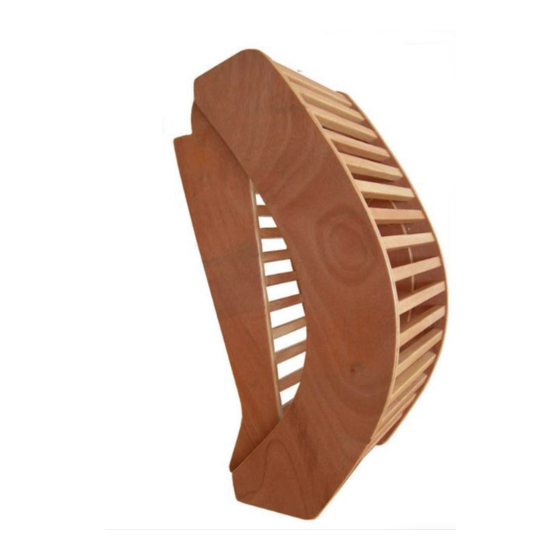
Table of Contents
Advertisement
Quick Links
foldaway backbender
• The backbender and Iyengar Yoga
• Basic handling
• Care
• Safe use
• Poses and assembly configurations
The backbender and Iyengar
Yoga
The Foldaway Backbender is a new
adaptation of BKS Iyengar's classic
'backbend bench' design.
BKS Iyengar is widely regarded as
the foremost contemporary teacher of
yoga asana (posture). His technique
emphasises precise alignment and
deep absorption in each pose. Based
at the Ramamani Iyengar Memorial
Yoga Institute in Puna, India, Mr
Iyengar's inspirational teaching has
spawned hundreds of Iyengar Yoga
schools around the world.
Now in his late eighties, he maintains
an active interest in the teaching
program at the Institute.
Fundamental to Mr Iyengar's approach
is the notion of practicing each
pose in a way which is appropriate
to the experience and fitness of the
practitioner. For that purpose he has
developed and systematised the use
of a number of yoga props.
Props assist the practice
of those unable to
achieve the deepest
version of a pose.
Props also enable
practitioners to stay in
a pose for a longer time
than would otherwise be
possible, especially during
a 'restorative' practice.
Mr Iyengar developed the
backbend bench to assist
with the practice of back
bends or poses involving
spinal extension (arching
the spine backwards)
The Foldaway Backbender
�������������������
was designed by Peter Harley. Peter
is an Iyengar Yoga teacher and
industrial designer, from Melbourne,
Australia. It adapts Mr Iyengar's original
design, enabling more versatile use
and space-saving, foldaway storage.
This more recent model also includes
an attachment for the practice of
supported Kapotasana.
Basic handling
The Foldaway Backbender is made
in 3 parts plus a removable foot bar.
��������������������
�������������
�������������
Take a little time to study the
mechanism to see how the
bench is folded, assembled and
disassembled. The diagrams
left and right show the parts
in the stored or folded
form.
The Foldaway
Backbender
(FAB) should
only be carried
in the folded
form and
gripped by
one of the large
diameter bars at the
top (Figure 1). Please
note that carrying the
bench in the unfolded form
users' guide
may result in its unexpected
folding and jamming your
fingers (Figure 2 overleaf).
To fold the bench from its
extended form simply lift
it by the large bar at the
centre. If it resists folding,
Feedback
Please send comments,
questions and feedback to:
info@iyogaprops.com.au
Thank you.
1
Advertisement
Table of Contents

Summary of Contents for IYOGAPROPS Foldaway backbender
- Page 1 The backbender and Iyengar This more recent model also includes Yoga an attachment for the practice of supported Kapotasana. The Foldaway Backbender is a new adaptation of BKS Iyengar’s classic Basic handling ‘backbend bench’ design. The Foldaway Backbender is made BKS Iyengar is widely regarded as in 3 parts plus a removable foot bar.
- Page 2 gently stretch it longer, then fold 3 Lay back and observe the sensation (Figure 3). in your spine. If uncomfortable move ✗ even closer to the bottom of the FAB The upper and lower sections can only so that your spine including your be disassembled and reassembled in neck becomes relatively flat (Fig 8).
- Page 3 ✗ ✓ Asanas (poses) The principles of safe use described above should be observed at all times. A number of poses are illustrated here, but experienced yoga practitioners may find the Foldaway Backbbender useful for other poses. Backbending (spinal extension) poses Viparita Dandasana (supported inverted staff pose) (Figure 12).
- Page 4 Foldaway Backbender is designed in Australia by Iyogaprops.com.au Foldaway Backbender is protected by international patents and design registrations. �������������������������� �������������������������� Kapotasana (pidgeon pose) The apparatus can Seated forward be set at 2 heights (Figure 20 a/b). The intensity bends of the pose can be further regulated by varying Do not overflex lower back.

Need help?
Do you have a question about the Foldaway backbender and is the answer not in the manual?
Questions and answers